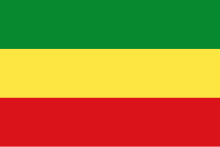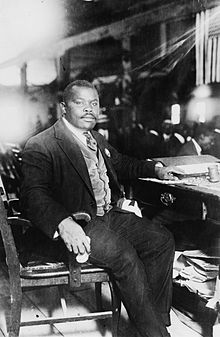Portal:Pan-Africanism
IntroductionWelcome to the Pan-Africanism portal!
Bienvenue sur le portail panafricanisme!   Pan-Africanism is a worldwide movement that aims to encourage and strengthen bonds of solidarity between all indigenous peoples and diasporas of African ancestry. Based on a common goal dating back to the Atlantic slave trade, the movement extends beyond continental Africans with a substantial support base among the African diaspora in the Americas and Europe. Pan-Africanism can be said to have its origins in the struggles of the African people against enslavement and colonization and this struggle may be traced back to the first resistance on slave ships—rebellions and suicides—through the constant plantation and colonial uprisings and the "Back to Africa" movements of the 19th century. Based on the belief that unity is vital to economic, social, and political progress, it aims to "unify and uplift" people of African ancestry. (Full article...) Selected article  The Pan-African colours are: green, gold (not yellow, despite its appearance), and red (inspired by the flag of Ethiopia). Red, black, and green are the colours of Black Nationalism, which should not be taken for a symbol of Pan-Africanism. It is often confused as such, given the political tendency’s support of Black self-determination. Selected biography
Marcus Mosiah Garvey Jr. ONH (17 August 1887 – 10 June 1940) was a Jamaican-born political leader, publisher, journalist, entrepreneur, and orator. He was President-General of the Universal Negro Improvement Association and African Communities League (UNIA-ACL). He also was President and one of the directors of the Black Star Line, a shipping and passenger line incorporated in Delaware. The Black Star Line went bankrupt and Garvey was imprisoned for mail fraud in the selling of its stock. His movement then rapidly collapsed. Prior to the 20th century, leaders such as Prince Hall, Martin Delany, Edward Wilmot Blyden, and Henry Highland Garnet advocated the involvement of the African diaspora in African affairs. Garvey was unique in advancing a philosophy to inspire a global mass movement and economic empowerment focusing on Africa known as Garveyism. Garveyism would eventually inspire others, ranging from the Nation of Islam to the Rastafari movement (which proclaim Garvey as a prophet) and the Black Power Movement of the 1960s. Selected history
The Ghana Empire (c. 700 until c. 1240), (Ghana or Ga'na being the title of its ruler), was located in the area of present-day southeastern Mauritania and western Mali. Complex societies based on trans-Saharan trade with salt and gold had existed in the region since ancient times, but the introduction of the camel to the western Sahara in the 3rd century A.D. opened the way to great changes in the area that became the Ghana Empire. By the time of the Muslim conquest of North Africa in the 7th century the camel had changed the ancient, more irregular trade routes into a trade network running from Morocco to the Niger river. The Ghana Empire grew rich from this increased trans-Saharan trade in gold and salt, allowing for larger urban centres to develop. The traffic furthermore encouraged territorial expansion to gain control over the different trade-routes. When Ghana's ruling dynasty began remains uncertain; it is mentioned for the first time in written records by Muḥammad ibn Mūsā al-Khwārizmī in 830. In the 11th century the Cordoban scholar Abuof travelled to the region and gave a detailed description of the kingdom. He claimed that the Ghana could "put 200,000 men into the field, more than 40,000 of them archers", and noted they had cavalry forces as well. As the empire declined it finally became a vassal of the rising Mali Empire at some point in the 13th century. When the Gold Coast in 1957 became the first country in sub-Saharan Africa to regain its independence from colonial rule, it renamed itself in honor of the long-gone empire. Selected culture
The traditional African religions (or traditional beliefs and practices of African people) are a set of highly diverse beliefs that include various ethnic religions. Generally, these traditions are oral rather than scriptural, include belief in a supreme creator, belief in spirits, veneration of the dead, use of magic and traditional medicine. Adherents of traditional religions in Sub-Saharan Africa are distributed among 43 countries and are estimated to number over 100 million. Although the majority of Africans are adherents of Christianity or Islam, African people often combine the practice of their traditional belief with the practice of Abrahamic religions. The two Abrahamic religions are widespread across Africa, though mostly concentrated in different areas. They have replaced indigenous African religions, but are often adapted to African cultural contexts and belief systems. West and Central African religious practices generally manifest themselves in communal ceremonies or divinatory rites in which members of the community, overcome by force (or ashe, nyama, etc.), are excited to the point of going into meditative trance in response to rhythmic or driving drumming or singing. One religious ceremony practiced in Gabon and Cameroon is the Okuyi, practiced by several Bantu ethnic groups. In this state, depending upon the region, drumming or instrumental rhythms played by respected musicians (each of which is unique to a given deity or ancestor), participants embody a deity or ancestor, energy or state of mind by performing distinct ritual movements or dances which further enhance their elevated consciousness. When this trance-like state is witnessed and understood, adherents are privy to a way of contemplating the pure or symbolic embodiment of a particular mindset or frame of reference. This builds skills at separating the feelings elicited by this mindset from their situational manifestations in daily life. Such separation and subsequent contemplation of the nature and sources of pure energy or feelings serves to help participants manage and accept them when they arise in mundane contexts. This facilitates better control and transformation of these energies into positive, culturally appropriate behavior, thought, and speech. Also, this practice can also give rise to those in these trances uttering words which, when interpreted by a culturally educated initiate or diviner, can provide insight into appropriate directions which the community (or individual) might take in accomplishing its goal. Selected imagesOrganisationsAll-African People's Revolutionary Party · African Society for Cultural Relations with Independent Africa · African Unification Front · African Union · African Queens and Women Cultural Leaders Network · Conseil de l'Entente · Convention People's Party · East African Community · Economic Freedom Fighters · Global Afrikan Congress · International African Service Bureau · International League for Darker People · Organisation of African Unity · Pan African Association · Pan-African Congress · Pan Africanist Congress of Azania · Rassemblement Démocratique Africain · Pan Africa Chemistry Network · Pan African Federation of Accountants · Pan-African Freedom Movement for East and Central Africa · Sahara and Sahel Observatory · UNIA-ACL · ZANU–PF
See also
& Festivals Photo by Helinä Rautavaara (1977) Publications
Films and TVAudios and videosDid you know...that Henry V. Plummer was a chaplain with the US Army Buffalo Soldiers, while his son H. Vinton Plummer was a leader in Marcus Garvey's secret service and militia?
Selected quotesIn his "Whirlwind Message", the First Message to the Negroes of the World from Atlanta Prison (10 February 1925), Marcus Garvey delivered the following message:
Pan-Africanism topicsCategoriesThings you can do
Related portalsAssociated WikimediaThe following Wikimedia Foundation sister projects provide more on this subject:
Discover Wikipedia using portals | |||||||||||||||||||||||||||||||||||||||||||||||||||||||||||||||||||||||||||||||||||||||

































